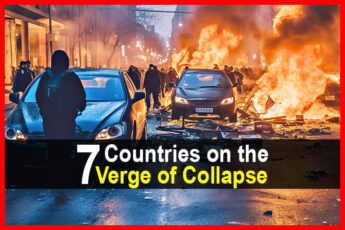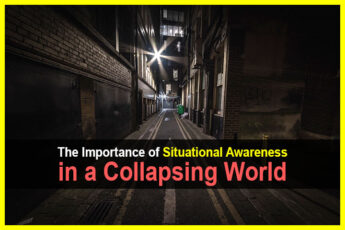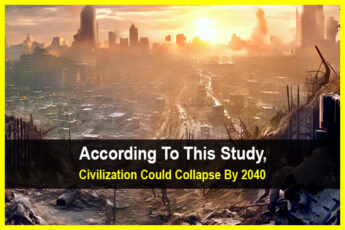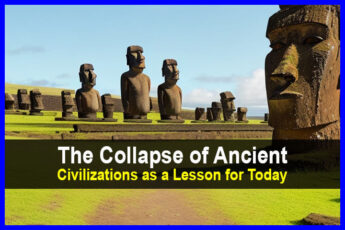Estimated reading time: 11 minutes
It’s easy to look back at ancient civilizations and take note of how they have collapsed. From the Mayans to the Persians to the Romans, civilizations and societies have all inevitably collapsed.
What’s troubling is that the historical patterns and precedents for a collapse are consistent and predictable. Contrary to what we see in the movies, societal collapse is rarely the result of catastrophic disasters.
They are usually a pattern of events the either cascade or compound to a tipping point when any single disastrous event can lead to a rapid failure of the country, society and its occupants.
Want to save this post for later? Click Here to Pin It On Pinterest!
It’s Happening Now
Around the world countries are collapsing into chaos with 10 of them either in a shambles of collapse or at the tipping point when any additional threat or challenge will take them down. Here are the countries we’ll cover and it’s worth looking at the patterns that have taken them to this point.
- Syria
- Venezuela
- Sudan
- Yemen
- Afghanistan
- Lebanon
- Somalia
- Ethiopia
- Haiti
- Argentina
Primary Drivers of Societal Collapse
Ø Economic Failure
A country’s economy is the engine that drives everything. When an economy falters or fails -its institutions, programs and businesses in general from agriculture to medical care begin to fade.
One of the standard symptoms of a failing economy is inflation and particularly hyperinflation. As the country’s currency loses value the ability of anybody to effectively buy basic goods and services becomes increasingly difficult.
Here’s a snapshot of how hyperinflation has affected many of the countries we’ve listed:
| COUNTRY | 2023 INFLATION RATE |
|---|---|
| Venezuela | 9,586% |
| Zimbabwe | 676% |
| Lebanon | 171.2% |
| Ghana (new in 2023) | 128% |
| Sierra Leone (new in 2023) | 123% |
| Haiti (new in March 2023) | 119% |
| Yemen | 110% |
| Turkey | 73.13% |
| Argentina | 72.37% |
| Sudan | 71.4% |
| Suriname | 42.58% |
| Iran | 39.99% |
| Ethiopia | 22.6% |
| UNITED STATES | 3.2% |
However, hyperinflation is not the only factor effecting the collapse of a country and its society, and in many countries another factor complicates stability and can even lead to hyperinflation: leadership.
Ø Political Polarization – From Democracy to Ideocracy to Autocracy
Failed states are often defined by a dictatorship. The leaders are charismatic and usually ruthless. They attract followers who lead desperate and frustrated lives and blindly follow not because the political leadership’s vision for society is defined by a goal to a better life, but a way to lead them from their unwanted selves.
The result is an “us or them” mindset that divides countries while the leadership imposes draconian measures from the use of troops to create a police state to the imprisonment of opposition.
- This has happened in Venezuela where President Nicholas Maduro has not only denied access to information through restriction of the internet, but the arbitrarily prosecution and detention of political opponents and critics.
- Bashaar Al Assad has directed his security forces to bomb his own people resulting in the death of close to 200,000 and has tortured and executed 11,000 opponents and critics. The country has been in the midst of civil war for a decade and it continues to this day.
- The brutal military dictatorship of Gen. Min Aung Hlaing in Myanmar routinely arrests and executes dissidents and critics while enriching members of the junta and ruling elite.
A common descriptor is a dictatorship also known as an autocracy and many countries around the world are ruled by a “closed” autocracy which defines the most restrictive level of dictatorship. On the other hand, electoral autocracies are supposedly the result of elections, but they rarely represent the true will of the population.
In fact, as of 2023 more countries in the world are ruled by autocracies rather than democracies. Here’s how our list of 10 shape up from a political leadership standpoint.
| COUNTRY | TYPE OF GOVERNMENT |
|---|---|
| Somalia | Closed autocracy (Dictatorship) |
| Syria | Closed autocracy (Dictatorship) |
| Venezuela | Electoral autocracy |
| Yemen | Closed autocracy (Dictatorship) |
| Haiti | Electoral autocracy |
| Sudan | Closed autocracy (Dictatorship) |
| Lebanon | Electoral autocracy |
| Afghanistan | Closed autocracy (Dictatorship) |
| Ethiopia | Electoral autocracy |
| Argentina | Electoral autocracy |
| UNITED STATES | LIBERAL DEMOCRACY |
What’s significant is that none of these countries have either an electoral democracy or a liberal democracy which are the other two basic definitions of a government.
The result is that a country’s leadership or lack of leadership is another primary factor weakening the society and taking it to a point of no return. In the case of Venezuela it was the decision of the previous President, Hugo Chavez and his successor Nicholas Maduro to base the entire economy on oil that led to collapse. As a dictatorship there was no debate or elected representatives to challenge the decision.
Venezuela has some of the largest oil reserves in the world but no other industries or resources were pursued or developed. When oil prices fell and as other countries pursued more aggressive ways to drill or import oil Venezuela’s economy collapsed. And that was just the beginning.
Ø Civil Unrest
No country is a stranger to civil unrest. In most instances the incidents defining civil unrest are short-term. It’s when a population or groups continue to engage in violent and disruptive activities that countries and societies begin to erode and fail as a result.
A lot of the drivers for civil unrest emerge when there is a wide disparity in income defining groups as “haves and have nots.” This is sometimes referred to statistically as the GINI Coefficient which defines the gap in income disparity in any society.
Another factor driving civil unrest is the perception of rampant corruption amongst leadership and government officials resulting in a “corruption index.”
Here are the ranges for the 10 countries in collapse.
| COUNTRY | CORRUPTION INDEX* | GINI COEFFICIENT RATE† |
|---|---|---|
| Somalia | 12 | 36.8% |
| Syria | 13 | No Data |
| Venezuela | 14 | 44.8% |
| Yemen | 16 | 36.7% |
| Haiti | 17 | 41.1% |
| Sudan | 22 | 34.2% |
| Lebanon | 24 | 31.8% |
| Afghanistan | 24 | No Data |
| Ethiopia | 38 | 35% |
| Argentina | 38 | 43.6% |
| UNITED STATES | 69 | 41.4% |
*The Corruption Index is a Measure of Political Corruption by The Government or it’s Leadership on a scale from 0 to 100. The lower the number the higher the corruption index.
†The GINI Coefficient Rate Measures Income Inequality Between the Working Class and the Elite Ruling Class. The Higher the number the higher the disparity between rich and poor.
(On a side note, South Africa has the highest GINI Coefficient rate at 63%.)
Other events can lead to civil unrest but it’s when civil unrest continues that a country and society become increasingly threatened. In many parts of the world civil unrest has devolved to full scale civil war.
Here’s an index of levels of civil unrest defined by violent protests, roving gangs or civil war driven by small militias and extremist groups around the world.
| COUNTRY | NATURE OF CIVIL CONFLICT |
|---|---|
| Afghanistan | Civil War (Taliban vs Resistance Groups) |
| Syria | Civil War |
| Sudan | Civil War (Paramilitary Warfare) |
| Yemen | Civil War (Houthi Rebels) |
| Lebanon | Political Instability (Civil Unrest) |
| Somalia | Extremist Militias (Al-Shabaab) |
| Venezuela | Political Instability (Civil Unrest) |
| Haiti | Gang Warfare (G9) |
| Argentina | Civil Unrest (Widespread rioting) |
| Ethiopia | Civil Conflict (Regional Militias) |
| UNITED STATES | Demonstrations and Riots |
To the Tipping Point
It’s rare that one, single event can cause the collapse of a country or society. It’s usually a combination of events that compound one on top of another, or a cascade of events where one set of bad decisions or events lead to others.
What’s significant is that as these situations worsen the society becomes weakened, and reach a tipping point where a significant disaster that can often be endured simply overwhelms a country and society leading to collapse.
Primary Triggers of Final Collapse
History has a wealth of examples of how droughts, volcanic eruptions, and wars have destroyed societies, countries and cultures. In many of those ancient instances there was already a pattern of events similar to what we’ve identified that had weakened them leading to their final collapse. Here are some of the events that often act as triggers for the final failure.
Climate Change
Forget about all of the opinions and arguments about why climate change is happening. The simple fact is that climate change has brought down civilizations in the past and it will happen again.
Worse, it’s happening now and weather patterns leading to years of drought, constant flooding, or freezing temperatures in previously warm areas can tip the scales to disaster.
Natural Disasters
Climate change is clearly in the category of natural disasters but other disasters from volcanic eruptions to earthquakes, tsunamis and pandemics can tip the balance just as quickly.
Here again, many of these disasters can be endured by a healthy society but when a country is weakened by corruption, political ineptitude, hyperinflation and growing unrest it is highly vulnerable.
War
Civil war significantly weakens a country but interstate-war or war with other countries will often leave one or both countries devastated. History again is a guide if you look at Europe after World War II and World War I all the way back to the wars that dominated the world for centuries.
War on its own is often enough to bring a country to collapse regardless of its condition, but the factors we’ve identified are what usually lead to war in the first place.
Today’s Tipping Points
Here’s a snapshot of the events that have proven to be the tipping points for the 10 countries that have collapsed or are collapsing.
| COUNTRY | TIPPING POINT |
|---|---|
| Afghanistan | Interstate Wars |
| Syria | Civil War |
| Sudan | Civil War |
| Yemen | Civil War |
| Lebanon | Political Corruption |
| Somalia | Drought |
| Venezuela | Hyperinflation |
| Haiti | Earthquakes |
| Argentina | Political Corruption |
| Ethiopia | Drought |
| UNITED STATES | ? |
Amidst the other crises that haunt many of these countries the final crisis or tipping point often leads to a worsening of events and begin to present the common symptoms of the collapse of a society or country.
These often lead to the final days of a country or society and as more and more parts of the world fall into despair it becomes increasingly difficult for other countries to come to their aid or provide any relief.
Symptoms of a Collapsed State
Widespread Water and Food Insecurity
The most direct impact across the population of any country in collapse is the lack of access to food and water. Hyperinflation is one factor but corruption and a failing economy compromise everything from agriculture to the power grid, municipal water resources and the supply chain for just about everything else.
It’s when the pictures of the starving babies with bloated bellies start to show up that the collapse has gone beyond the tipping point. The malnutrition that results compromises immune systems across the population and the desperate need for water drives people to consume water from any source.
The result of malnutrition and polluted water supplies leads to the next symptom.
Epidemics and Pandemics
History again tells the story as plagues and pandemics have destroyed populations. As the world’s population continues to grow exponentially the crowded conditions only increase the likelihood of the spread of disease.
Worse, today’s ability for anyone to travel across the globe in a day makes our modern transportation technologies the new vector for disease transmission. COVID-19 was only a small sample of how an epidemic or pandemic can devastate nations.
Here’s a chart of some of the epidemics and pandemics that have further devastated the 10 countries we’ve focused on over the past 10 years. All were affected by COVID-19.
| COUNTRY | TIPPING POINT |
|---|---|
| Afghanistan | TYPHOID, CHOLERA, DENGUE, AWD |
| Syria | MERS, COVID-19, CHOLERA |
| Sudan | EBOLA, AIDS, DENGUE, MALARIA, ZIKA |
| Yemen | EBOLA, POLIO, AIDS, DENGUE, MALARIA |
| Lebanon | CHOLERA |
| Somalia | EBOLA, POLIO, AIDS, DENGUE, MALARIA |
| Venezuela | MALARIA, DENGUE, ZIKA |
| Haiti | CHOLERA |
| Argentina | PNEUMONIA |
| Ethiopia | EBOLA, POLIO, AIDS, DENGUE, MALARIA |
| UNITED STATES | AIDS, TUBERCULOSIS |
It’s the outbreak of disease leading to epidemics that often drive countries from the tipping point to the brink. In most instances their medical services were already compromised or simply non-existent. The rapid pace and constant fear of spreading infection, particularly from water-borne illnesses like typhoid and cholera, will often drive people to the next and final symptom of collapse.
Emigration
Refugees are another sad and unfortunate fact of history. Once again we’ve all seen the photos of desperate people walking with exhaustion while they carry their few possessions on their backs.
The current crisis at the Southwest border of the U.S. has been largely driven by people fleeing Venezuela. The unfortunate fact is that people emigrating from a failed state are rarely welcomed. Here’s a sample of today’s statistics:
- 400,000 people have emigrated from Sudan to Chad and the result has overwhelmed Chad to the point that it is now on the brink of collapse.
- 7.1million Venezuelans have emigrated from the country since 2015. 80% of those refugees are currently living in other Latin and Central American countries with the remaining 20% continuing to seek asylum in the United States and other locations.
- 1 million people have emigrated from Argentina in the last 10 years.
It’s a simple equation. When life becomes unbearable you simply need to go somewhere else. In fact, the disappearance of ancient civilizations was largely due to the fact that people simply relocated to somewhere else, and abandoned their grand cities and monuments when a collapse occurred.
Can it Happen Here?
It’s hard to imagine a developed nation and economy like the United States suffering a collapse like some of the countries we’ve identified. Then again, many assumed Venezuela’s oil reserves made its economy invincible, and Lebanon was once an oasis of luxury in the Middle East.
We’ve identified the facts and statistics in each chart and for the most part, the U.S. does not have the levels of inflation, corruption, or civil conflict that has affected these failed societies.
Then again, the economic disparity in the U.S. is high; there is a high degree of political polarization, and as COVID proved –everyone is susceptible to a disaster like disease.
The critical thing is to watch the barometer of facts and statistics we’ve identified and recognize the symptoms of collapse. When people start leaving the country or when no water is safe to drink, maybe it’s time to do the big bug out. The only question is where in the world would you go?
Like this post? Don't Forget to Pin It On Pinterest!









